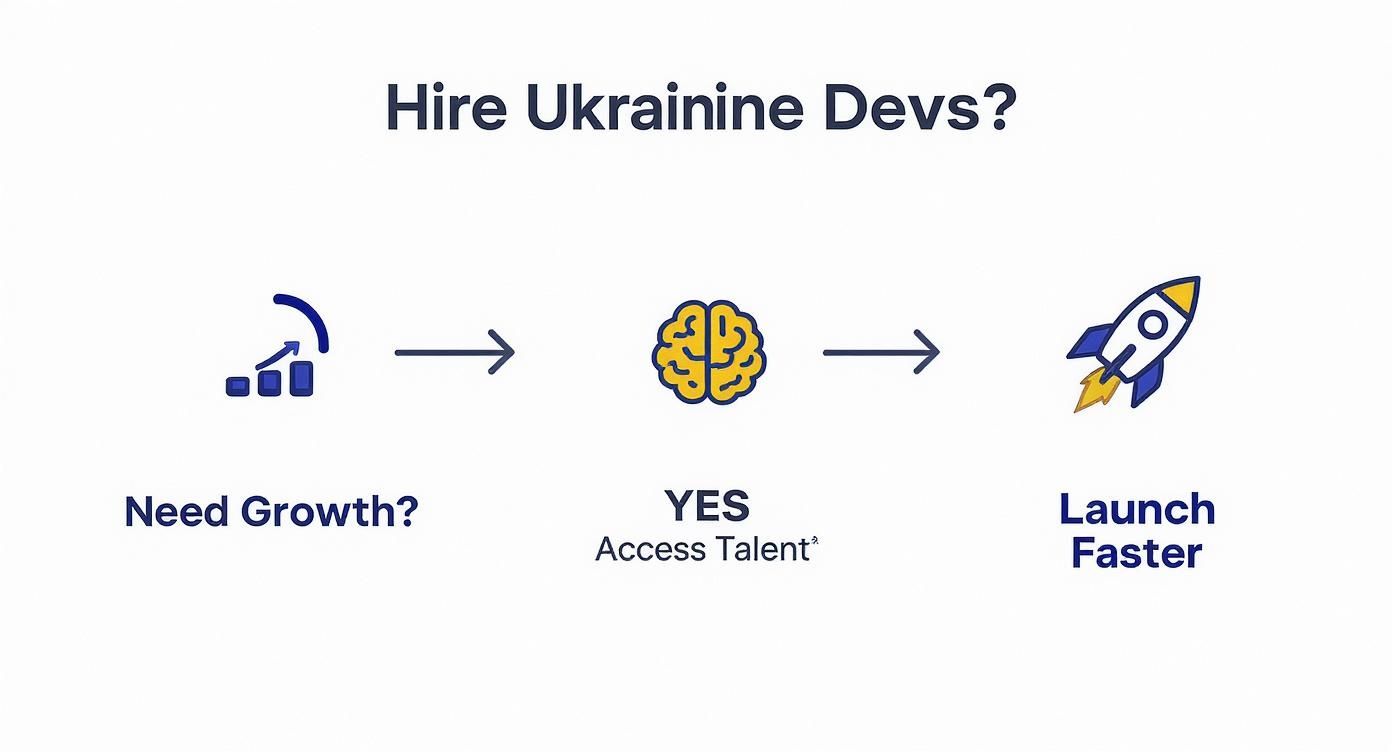How to Hire a Dedicated Development Team in Ukraine and Scale Your Business
Building a dedicated development team in Ukraine is a strategic move for businesses looking to accelerate growth. It combines world-class engineering talent with significant cost efficiencies, allowing you to innovate faster and extend your product roadmap without the high overhead of local hiring. This guide provides an actionable framework for leveraging Ukraine’s tech ecosystem to achieve your business goals.
Why Ukraine is a Premier Tech Talent Hub
Global companies prioritize locations that offer a strategic blend of skill, value, and stability. Ukraine consistently emerges as a top choice, not just for its competitive pricing, but for the exceptional quality and depth of its engineering talent. Understanding the ‘why’ behind this reputation is the first step toward building a high-performance global team.
The country’s tech leadership is no accident; it’s the result of a robust technical education system that consistently produces skilled graduates. When you hire a dedicated development team in Ukraine, you are accessing a vibrant community of expert problem-solvers fluent in today’s most complex technology stacks.
Deep and Specialized Talent Pool
The sheer volume of tech professionals in Ukraine is impressive, but the real advantage lies in their specialized skills. The IT sector has experienced explosive growth, now boasting over 300,000 skilled software engineers—a figure that has grown over 7% in the past year. This talent pipeline is continuously fed by more than 20,000 IT graduates annually.
This is why 20% of Fortune 500 companies operate remote development teams in Ukraine. They are drawn by deep technical expertise, strong cultural alignment, and excellent communication skills. A remarkable 85% of Ukrainian tech professionals possess at least an intermediate command of English, ensuring seamless collaboration. For additional context, you can discover more insights about the Ukrainian IT landscape on acropolium.com.
This diverse talent pool is a significant advantage for industries requiring niche expertise:
- SaaS & Tech: Access a deep well of engineers who are experts in cloud-native architecture, microservices, and AI/ML implementation.
- FinTech: Find developers with proven experience in blockchain, cybersecurity, and financial compliance protocols.
- E-commerce: Hire specialists in data analytics, personalization engines, and scalable platform architecture.
At Group107, we connect clients directly with these specialists. Our model for a dedicated offshore software development team focuses on full integration, ensuring the team’s objectives are perfectly aligned with your business outcomes.
The data confirms Ukraine’s position as a leading tech hub where technical excellence is the standard.
Ukrainian Talent Pool at a Glance
| Metric | Statistic | Business Impact |
|---|---|---|
| Total Tech Professionals | 300,000+ | Access to a vast, scalable workforce. |
| Annual Growth Rate | 7% | Sustainable access to new talent. |
| Annual IT Graduates | 20,000+ | Continuous pipeline of skilled engineers. |
| Fortune 500 Presence | 20% | Proven and trusted by leading global enterprises. |
| English Proficiency | 85% (Intermediate+) | Seamless communication and collaboration. |
These figures demonstrate a mature, growing, and globally-integrated tech ecosystem.
Unmatched Cost-Efficiency and Value
While cost savings are a significant benefit, the conversation has shifted from “cheaper” to “smarter.” Hiring a dedicated team in Ukraine delivers exceptional value. Businesses can often assemble a full team of senior and mid-level engineers for the cost of one or two senior developers in the US or Western Europe.
This isn’t merely about reducing operational costs; it’s about maximizing ROI. The budget saved can be reinvested into other critical business functions like marketing, R&D, or infrastructure scaling. For a SaaS startup, this means a longer runway and a faster path to profitability. For an enterprise, it means completing more strategic projects without exceeding budget constraints.
Proven Resilience and Adaptability
The resilience of Ukraine’s tech sector is remarkable. Despite facing significant geopolitical challenges, the industry has not only survived but thrived, demonstrating an extraordinary capacity to adapt and deliver. IT companies swiftly implemented robust business continuity plans, ensuring clients experienced minimal to no disruption.
This proven stability provides global businesses with immense confidence. It validates that both the infrastructure and the people are prepared to deliver high-quality work consistently, regardless of external factors. This resilience makes a dedicated development team from Ukraine a reliable and strategic asset for any organization.
Selecting the Right Engagement Model for Your Project
Choosing the right engagement model is a foundational strategic decision. It dictates your level of control, cost structure, and scalability. You are not just hiring developers; you are architecting a collaboration framework designed to achieve specific business goals. The model you select should directly align with your project’s complexity, duration, and strategic importance.
Dedicated Team Model
The Dedicated Team model is the most integrated option. You get a hand-picked, full-time group of professionals who work exclusively on your project, becoming a genuine extension of your in-house staff. This approach is ideal for long-term projects with evolving scopes where deep domain knowledge is critical for success.
- Best For: SaaS product development, complex enterprise applications, and long-term initiatives.
- Business Scenario: A FinTech company building a new digital banking platform requires a stable, fully integrated team (backend, frontend, QA, PM) that can focus 100% on the product roadmap over several years. The dedicated model provides the necessary stability and focus.
Staff Augmentation Model
Staff Augmentation offers a more surgical approach. Instead of outsourcing an entire project, you select individual specialists to fill specific skill gaps within your existing team. It’s perfect for acquiring niche expertise—like a senior DevOps engineer or an AI specialist—without the commitment of a full-time hire.
- Best For: Projects needing specialized skills (AI/ML, DevOps, cybersecurity), temporary scaling for a critical project phase, or backfilling a team member.
- Business Scenario: An e-commerce enterprise preparing for a major cloud migration can use staff augmentation to bring on two senior DevOps engineers for six months. These experts embed with the internal team, lead the migration, transfer critical knowledge, and then transition off the project upon completion.
This decision tree helps visualize how your specific business needs map to the optimal engagement model. The ultimate goal is always sustainable growth and a faster time-to-market.
Whether you need to inject specialized talent or accelerate an entire product launch, a Ukrainian development team provides a clear and effective path to achieving your objectives.
Project-Based Model
The Project-Based model (also known as fixed-price) is designed for smaller projects with a well-defined scope, requirements, and deadline. You agree on specific deliverables and a fixed cost upfront, and the vendor partner manages the entire development process from start to finish.
- Best For: MVP development, standard website creation, or adding a specific feature where the scope is not expected to change.
- Business Scenario: A marketing agency needs a custom WordPress site for a client with a fixed budget and a three-month deadline. The project-based model provides complete cost predictability and ensures on-time delivery without requiring day-to-day project management from the agency.
This table provides a clear comparison of the models.
Engagement Model Comparison for Ukrainian Dev Teams
| Model | Best For | Control Level | Cost Structure | Business Outcome |
|---|---|---|---|---|
| Dedicated Team | Long-term, complex projects with evolving scope (e.g., SaaS products). | High – team is an extension of your own. | Monthly fee per team member. | Accelerated innovation, deep product ownership. |
| Staff Augmentation | Filling specific skill gaps or scaling for a short-term need. | High – specialists integrate with your in-house team. | Monthly fee per individual. | Increased team velocity, access to niche skills. |
| Project-Based | Small-to-medium projects with well-defined, fixed requirements. | Low – vendor manages the entire process. | Fixed price for the whole project. | Predictable budget and timeline for specific tasks. |
The right model is critical. While the project-based model works for defined scopes, the Dedicated Team model provides the deep integration necessary for complex, evolving products. It’s the difference between hiring a contractor and building a core component of your engineering organization. Learn how we structure a dedicated offshore software development team for maximum business impact.
A key advantage of Ukrainian teams is their experience level. The tech workforce is mature, with 42% of developers at the mid-level and 26% at the senior level. Furthermore, 85% of Ukrainian developers actively engage in professional development, ensuring your team is equipped to tackle modern challenges in cloud computing, data science, and AI. This makes a dedicated development team from Ukraine a forward-thinking and reliable partner.
How to Vet and Hire Your Ukrainian Development Team
Securing the right talent for your dedicated development team in Ukraine is the most critical step in the process. This requires moving beyond simple resume matching to a structured evaluation of skills, problem-solving ability, and cultural fit. A superficial vetting process is a direct path to project failure. This section outlines a multi-layered framework to ensure your chosen partner and their proposed team align perfectly with your technical roadmap and business objectives.
1. Create a Precise Technical Skills Matrix
Before engaging vendors, define your requirements with a detailed technical skills matrix. A generic job description is insufficient. Instead, map every required competency by role and seniority.
Go beyond just listing technologies. Classify each skill as “must-have” or “nice-to-have” and specify the required proficiency level (e.g., expert, proficient, familiar).
Example for a SaaS Product Team:
- Senior Backend Developer: Expert in Node.js, proficient with microservices architecture (Kubernetes), and familiar with AWS Lambda.
- Mid-Level Frontend Developer: Proficient in React and TypeScript, with practical experience using component-based design systems.
- Senior DevOps Engineer: Must-have expertise in Terraform, CI/CD pipeline automation (Jenkins), and advanced monitoring (Prometheus).
This level of detail provides a clear blueprint for your partner to identify the right candidates efficiently.
2. Design Practical and Relevant Coding Challenges
Generic whiteboard exercises rarely predict on-the-job performance. Instead, design a practical coding challenge that reflects a real-world task your team would encounter. This is the most effective way to gauge coding talent, problem-solving methodology, and attention to detail.
Real-World Example: For a FinTech application, provide candidates with a sample set of transaction data and ask them to build a small API endpoint that aggregates the data in a specific format. Intentionally leave the instructions slightly ambiguous to observe how they handle uncertainty and what clarifying questions they ask. This reveals more about a developer’s thinking and communication style than a standard algorithm test.
3. Ask Behavioral Questions That Reveal Problem-Solving Skills
Technical proficiency is only one part of the equation. You need a team that demonstrates resilience, collaboration, and ownership. Behavioral questions are key to assessing these soft skills.
Move beyond generic questions. Use specific, situational prompts:
- “Describe a time when project requirements changed abruptly mid-sprint. How did you adapt, and what was the outcome?”
- “Walk me through your process for debugging a complex issue that wasn’t immediately obvious. What tools and strategies did you use?”
- “Tell me about a technical decision you made that you later recognized as a mistake. How did you identify the error, and what steps did you take to correct it?”
The responses will reveal their communication style, resilience, and professional maturity—all critical indicators of a strong long-term partner.
The purpose of an interview is to simulate the work environment, not to trick candidates. You want to see how they perform under realistic pressure and articulate their thought process. This is how you identify top-tier talent.
4. Scrutinize Vendor Portfolios and Conduct Smart Reference Checks
A vendor’s portfolio should demonstrate more than just finished products. Look for case studies relevant to your industry and project complexity. A portfolio of simple marketing websites is a red flag if you are building an enterprise-grade platform.
Dig into the specifics: What was the vendor’s precise role? What technical challenges did they solve? What were the tangible business outcomes?
When conducting reference checks, ask targeted questions to uncover the reality of the partnership:
- “How did the team handle unexpected technical debt or project roadblocks?”
- “Describe their communication and reporting process. Was it transparent and proactive?”
- “Was there any staff turnover during your project? If so, how did the vendor manage the transition?”
This level of due diligence helps you differentiate a true strategic partner from a simple code vendor.
Locking Down Your Contracts, Security, and IP
When hiring a dedicated development team in Ukraine, your contract is the operational blueprint for a secure and transparent partnership. It aligns expectations, protects your intellectual property (IP), and establishes a clear governance structure. Using a generic template or rushing this step can lead to significant legal and operational risks down the line.
A well-drafted legal agreement defines roles, responsibilities, and rules of engagement, protecting your business, your data, and your investment.
Must-Have Clauses in Your Agreements
Your legal framework should consist of a Master Service Agreement (MSA) and a Statement of Work (SOW). The MSA governs the overall relationship, while the SOW details the specifics of each project.
These clauses are non-negotiable:
- Intellectual Property (IP) Rights: The contract must state unequivocally that all work product—including code, designs, and documentation—created by the team for your project is 100% owned by you. This clause should cover copyrights, patents, and trade secrets, ensuring ownership is transferred upon creation or payment.
- Confidentiality and Non-Disclosure (NDA): A robust NDA is essential. It must legally bind the vendor and every team member to protect your confidential information, from business strategies to user data. This obligation should extend well beyond the contract term.
- Data Protection and GDPR Compliance: If your business processes data from EU citizens, GDPR compliance is mandatory. The contract must detail data processing terms, specific security measures, and the vendor’s legal responsibility to adhere to these regulations. This demonstrates your commitment to data privacy and mitigates the risk of significant fines.
- Liability and Indemnification: This clause clarifies responsibilities and protects your company from legal issues arising from the vendor’s work, such as IP infringement or a confidentiality breach. It minimizes your financial and legal exposure.
A common error is treating contracts as a formality. Your agreements must be tailored to your project’s specific risks. A FinTech platform has different compliance requirements than a SaaS product with sensitive user data, and your contract must reflect these nuances.
A Practical Checklist for Technical Security
Legal agreements are necessary but not sufficient. You also need a practical, day-to-day security strategy to protect your digital assets. A mature development partner will not just agree to security standards but will actively implement them.
Establish these baseline security practices before granting any system access:
- Secure Network Access: Mandate the use of a corporate VPN for all team members accessing your development environments to encrypt traffic and prevent unauthorized access.
- Multi-Factor Authentication (MFA): Enforce MFA across all critical tools, including code repositories (GitHub, GitLab), project management software (Jira), and communication platforms (Slack, Microsoft Teams).
- Role-Based Access Control (RBAC): Apply the principle of least privilege. Developers should only have access to the specific code and data required for their tasks. Regularly audit these permissions.
- Vendor Security Certifications: Prioritize partners with recognized security certifications like ISO 27001, which demonstrates a systematic and audited approach to information security management.
- Secure Device Policies: Verify that your partner enforces clear policies for developer workstations, including encrypted hard drives, up-to-date antivirus software, and correctly configured firewalls.
Implementing these measures is fundamental to protecting your IP and infrastructure. For more details, read our guide on how to hire a remote team safely. Combining strong contracts with disciplined security practices builds a partnership on a foundation of trust and safety.
Onboarding and Managing Your Team for Success
With the contract signed, the focus shifts to integration. A structured onboarding process is essential for integrating your new dedicated development team from Ukraine and setting them up for immediate impact. A rushed onboarding leads to confusion and lost momentum, while a thoughtful process creates a foundation for a successful long-term partnership. The objective is to make the new members feel like a genuine extension of your in-house staff, fully aligned with your mission and culture.
Actionable 30-Day Onboarding Checklist
A structured 30-day plan ensures a smooth transition and rapid productivity.
Week 1: System Access and Team Integration
- Provision all necessary accounts and permissions for code repositories (GitHub, GitLab), project management tools (Jira, Asana), and communication platforms (Slack, Teams).
- Conduct a formal kickoff meeting to introduce the new developers to key stakeholders.
- Schedule one-on-one meetings between Ukrainian team members and their in-house counterparts to build personal connections.
Week 2: Project Deep Dive and Technical Alignment
- Provide a thorough walkthrough of the codebase, architecture, and technical documentation.
- Review the product roadmap, quarterly business goals, and the objectives for the first sprint.
- Assign each new developer a small, low-risk “starter task” to help them familiarize themselves with the development environment and deployment process.
Weeks 3-4: Full Integration and First Deliverables
- Integrate the new team into all Agile ceremonies, including daily stand-ups, sprint planning, and retrospectives.
- Establish clear communication protocols, defining expectations for updates in Slack versus Jira tickets.
- Collaborate on the first full sprint, focusing on clear communication and delivering tangible value.
Setting and Tracking Meaningful KPIs
To ensure your dedicated development team in Ukraine is delivering business value, you must track KPIs that measure both productivity and quality.
Vague metrics yield vague results. Focus on concrete data that demonstrates execution quality. A data-driven approach eliminates ambiguity and fosters a culture of continuous improvement.
Key metrics to monitor:
- Sprint Velocity: The amount of work completed per sprint. Tracking velocity improves timeline forecasting and helps identify productivity bottlenecks.
- Cycle Time: The time it takes for a task to move from “in progress” to “done.” A consistently short cycle time indicates an efficient workflow.
- Code Quality Metrics: Use automated tools to monitor metrics like code churn, bug density, and adherence to coding standards.
- Sprint Completion Rate: The percentage of planned work that is completed within a sprint. A high rate indicates accurate estimation and reliable delivery.
Monitoring these KPIs provides objective data for performance discussions and process optimization. This commitment to measurable results has fueled the Ukrainian IT sector’s growth, which is projected to exceed $9 billion in export revenues by 2025. You can learn more about Ukraine’s pivotal role in the global IT market on cloverdynamics.com.
Scaling Your Team and Avoiding Common Pitfalls
As your project matures, your team will need to grow. Scaling a dedicated development team in Ukraine requires a strategic plan to manage growth effectively. When done correctly, scaling amplifies your ROI. Without a clear strategy, however, it can introduce friction, dilute culture, and create knowledge silos. The goal is to increase output without sacrificing the agility that made your initial team successful.
Forecasting and Planning Your Growth
Strategic scaling starts with workforce planning that directly links your hiring strategy to your product roadmap and business goals.
Ask these key questions:
- What are the critical features for the next 6-12 months? This identifies the specific talent you need, whether it’s more backend capacity, frontend expertise, or a specialized QA engineer.
- Where are our current bottlenecks? If a slow CI/CD pipeline is hindering progress, your next hire should be a DevOps engineer, not another feature developer.
- Can we promote from within? Look for opportunities to develop existing talent. Promoting a mid-level developer to a senior or lead role rewards performance and improves retention.
This forward-looking approach shifts you from reactive hiring to a deliberate process that supports sustainable growth. It is also essential for effective budget management. For a detailed breakdown, refer to our guide to offshore team cost calculation.
Scaling is about adding the right capabilities at the right time. A well-timed hire can unblock your entire team, whereas a rushed one creates more problems than it solves.
Avoiding Common Scaling Mistakes
As your team expands, new challenges will emerge. Awareness is the first step toward mitigation.
Here are common traps and how to avoid them:
- Communication Breakdowns: Communication methods that work for a team of five fail for a team of fifteen. Formalize processes by documenting key decisions in a central knowledge base (Confluence, Notion) and creating dedicated Slack channels for specific topics.
- Diluted Company Culture: Culture requires active cultivation. Reinforce company values during onboarding, organize virtual social events to connect team members across time zones, and encourage cross-team collaboration to build strong professional relationships.
- Knowledge Silos: It’s easy for team members to become isolated in one part of the product. Prevent this by embedding knowledge-sharing into your workflow through regular code reviews, “lunch and learn” sessions, and rotating developers between teams to distribute expertise.
Summary and Next Steps
Hiring a dedicated development team in Ukraine offers a powerful strategic advantage for companies aiming to scale efficiently, innovate faster, and optimize their technology investments. By leveraging a deep talent pool, proven resilience, and significant cost efficiencies, you can build a high-performing engineering team that drives tangible business results.
Key Takeaways:
- Strategic Advantage: Ukraine provides access to over 300,000 highly skilled and experienced tech professionals.
- Cost-Efficiency: Achieve up to 60% in cost savings compared to local hiring, allowing for greater investment in growth.
- Right Model is Key: Choose the engagement model (Dedicated Team, Staff Augmentation, Project-Based) that aligns with your project’s scope, duration, and strategic goals.
- Vet Thoroughly: Implement a rigorous vetting process that includes technical matrices, practical coding challenges, and in-depth reference checks.
- Onboard Strategically: Use a structured 30-day onboarding plan to integrate your new team and ensure they are productive from day one.
Actionable Next Steps:
- Define Your Needs: Create a detailed technical skills matrix outlining the specific roles and expertise your project requires.
- Evaluate Potential Partners: Research vendors with proven experience in your industry and a strong track record of building successful dedicated teams.
- Prepare Your Onboarding Plan: Draft a 30-day onboarding checklist to ensure a smooth and effective integration process.
- Establish Security Protocols: Define your security requirements, including MFA, VPN usage, and RBAC, before granting system access.
Ready to build a high-performing engineering team that drives results? Group107 provides premium offshore development teams from Ukraine, fully embedded into your organization to accelerate your product roadmap and scale your business. Learn more about our dedicated teams.







